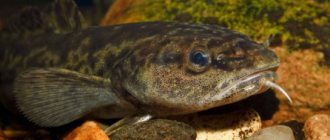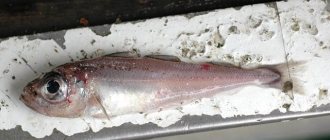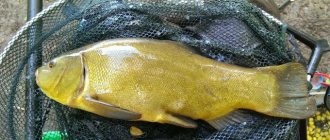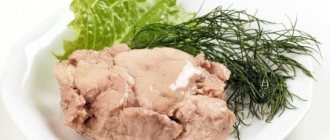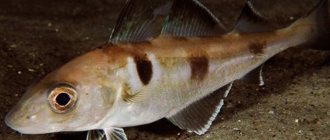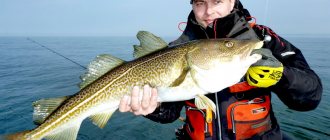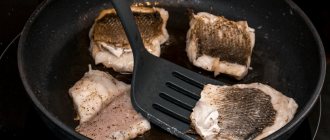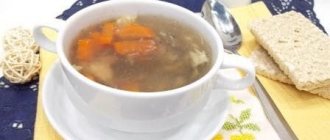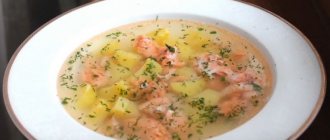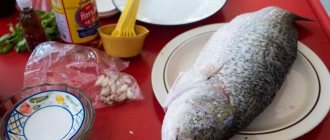Red cod or bacchus (in English the name red codling or hoka has taken root) is a valuable commercial fish. It got its name from the reddish tint of its skin. 20-30 minutes after removal from the water, the carcass acquires a pinkish tint. In fact, cod has nothing to do with red fish. This is a white variety. But this in no way detracts from the delicious properties of the product. Bacchus dishes are prepared not only at home, but also in restaurants in countries where this marine creature is most abundant.
What does the fish look like and how does it differ from other cod fish?
Red cod is a small fish. The average representative reaches 60 cm. But there are also large individuals over a meter in length. Mature medium-sized specimens are of commercial value, since the meat of large cod representatives is tougher, and some of the taste is lost with age.
Brian Gratwicke Red codling – Pseudophycis bachus https://www.flickr.com
The body of the fish is elongated, oblong. In its natural habitat it has a grayish or slightly pink tint. Once removed from water, it turns deep pink, which is how it got its name. Ends with a large head. The scales are small and can be easily removed without any special thermal or mechanical treatment.
Interesting to know! The habitat of red cod is the Kara, White, and Barents Seas. The largest number of representatives of the species is found off the coast of Australia and New Zealand.
The weight of an average individual varies from 0.8 to 2 kilograms. Red cod differs little in nutritional value from its “relatives”. However, bacchus meat has a more delicate consistency, a rich, but not sharp fishy taste and aroma. Thanks to this, the variety is highly valued.
Classification and varieties
There are different types of cod. They differ in size, color and other features depending on environmental conditions. When answering the question of whether cod is a sea or river fish, one should take into account the variety. Most of the representatives live in salty waters.
Atlantic cod is considered the largest variety. It can grow up to 1−2 m; the average size does not exceed 80 cm. The classic subspecies has a greenish color. The Kildinskaya variety lives in Russia, in the Murmansk region, and is small in size. Is endemic; attempts to settle in other bodies of water were unsuccessful. Baltic northern cod grows up to 1 m. Its weight often exceeds 10 kg.
Pacific cod has a wider, more massive head than the inhabitant of the Atlantic Ocean. The length varies from 45 to 90 cm. Body weight can reach up to 22 kg. This sea cod is found in the waters of the Sea of Okhotsk, Japan, and Bering Sea. There is also a Greenland subspecies, which some researchers identify as a separate species.
Another variety is Arctic. This fish inhabits the Arctic Ocean. There are Far Eastern and Ice subspecies, which are characterized by a gray color. The dimensions are small, the maximum body length is 55 cm, weight - no more than 1 kg.
The only freshwater cod is the burbot. This representative of the family is a bottom predator.
Nutritional properties of red cod
Fish of this species is considered dietary. Calorie content per 100 grams is about 68-72 kcal. It can be used for preparing first and second courses and snacks. It is allowed for diabetics, patients with hypertension, heart disease, and atherosclerosis.
Nutritional value of red cod per 100 grams:
- proteins: ~16.9 g;
- fats: ~0.6 g;
- carbohydrates: 0 g;
- water: 82 g.
Red cod contains a large amount of vitamins B, A, C and more. 100 grams contain:
- vitamin A: ~10 mcg;
- B1: 0.088 µg;
- B2: 0.06 µg;
- B6: 0.165 mcg;
- B9: 11.3 mcg;
- B12: 15 mcg;
- vitamin C: 1 mcg;
- vitamin E: 0.9 mcg;
- biotin: 9.95 mcg;
- PP: 5.79 mcg.
It contains potassium, sulfur, phosphorus, sodium, chlorine, magnesium, and sulfur in large quantities. Also omega-3, omega-6 polyunsaturated fatty acids. By consuming at least 100-200 grams of red cod per day, you can cover the daily need for phosphorus, chromium, cobalt, and almost half of the need for sulfur.
Cod, benefits and harm to the human body
What is cod?
The habitat of cod covers the temperate region of the Atlantic Ocean, forming several geographical subspecies: Arctic, White Sea, Baltic, etc. In the eastern part of the Atlantic, cod is distributed from the Bay of Biscay to the Barents Sea and Spitsbergen; in the west - from Cape Hatteras (North Carolina) to Greenland.
Cod is one of the most important commercial fish. Its liver, rich in fat (up to 74%), is a source of fish oil (animal fat obtained from a large, 1.3-2.2 kg liver) and a raw material for the production of popular canned food.
Codfish are divided into cod itself (cod, haddock, pollock, saffron cod), hake and burbot. In our catches they make up almost 30% of the total mass of fish caught. These are sea fish, the only exception is #8212; freshwater burbot.
Fish of the cod family are especially numerous and diverse in the waters of the North Atlantic and northern Pacific Ocean.
Hake meat is fattier, and the liver #8212; smaller and fattier than cod.
Consumers highly value the unique, bright and very pleasant smell of fried navaga. Freshly caught, timely processed and sold cod fish have a delicate and pleasant smell, somewhat reminiscent of the smell of crustaceans. But under less favorable conditions of processing, transportation and storage, the natural odor of cod can sharply intensify and change, gradually worsening.
Cod (especially Atlantic) has tasty, aromatic meat with a pleasant consistency.
Raw cod meat typically contains 17-19% protein and 0.3-0.9% fat. The catches are now dominated by cod weighing from 0.8 to 4 kg.
Frozen cod is produced mainly gutted, headless, carcasses and, increasingly, in the form of fillets.
Beneficial features:
Even the ancient Scandinavians dried cod in the cold without salt, took light plates with them on sea voyages and chewed them for weeks, fighting the waves and wind, on longships. In essence, cod is a resource of concentrated, complete protein that can be stored for a long time.
Our intelligence and mental development largely depend on the presence of sufficient iodine in the diet. Cod, like many other sea fish, contains large amounts of this essential microelement, so eating it (especially for pregnant and lactating women, as well as children in the developmental stage) will have a positive effect on the development of mental abilities.
Cod contains up to 1.6 mcg of vitamin B12, which can influence blood formation processes in the body. In addition, vitamin B12 (and, accordingly, cod) activates blood clotting processes.
Fish fillet can be successfully taken during a diet, if you want to lose weight and control it. Fish is one of the most important sources of protein for those who fast or do not eat animal meat. Cod is a healthy product for the nervous system; its high potassium content helps improve the transmission of impulses along nerve fibers. Phosphorus contained in fillets is involved in the formation of bone and cartilage tissue, zinc actively restores hair follicles and prevents gray hair from appearing. Sulfur, zinc, selenium are “beauty” microelements that are necessary for the successful growth of hair, nails, and excellent skin condition.
In the pharmaceutical industry, fish oil is obtained from the liver, which is widely used not only in medicine, but also in cosmetology. And a special brightening additive for glue is made from the fish’s swim bladder. Fish oil mixed with vegetable oil serves as an excellent hair mask that will quickly put it in order and stop hair loss and split ends. For the face, masks are prepared from cod roe.
Contraindications:
In large quantities, cod can cause intestinal upset or vomiting.
Like any other fish, cod can sometimes be a carrier of parasites. To avoid contamination, it is necessary to carefully handle the product before use. The best method for preventing helminthic diseases is heat treatment.
Fish is contraindicated in case of individual intolerance or allergies. People with urolithiasis and cholelithiasis should treat this product more carefully. Under no circumstances should cod liver be consumed if you have hyperthyroidism, hypertension, hypercalcemia, or if there is an excess of vitamin D. In other cases, if cod is not overused, it will not cause any harm.
How to cook cod
Cod baked in foil:
- fish fillet – 1 kg;
- pitted olives – 200 g;
- extra virgin olive oil – 75 g;
- lemon – 1 pc.;
- dill – 1 bunch;
- dill seeds – 0.5 tsp;
- cumin seeds – 0.5 tsp;
- cumin – 1/4 tsp;
- garlic – 1 large clove;
- pepper, salt.
Finely chop the dill, add dill seeds, cumin, caraway seeds, finely chopped garlic, pepper, salt, oil and cook in a thick-bottomed frying pan over very low heat under the lid for 10 minutes. Cool.
Cut the fish into 4 parts.
It's all in an envelope. The taste is excellent. And the usefulness of the product is indicated by its composition and method of preparation.
https://prokalorijnost.ru/treska-polza-i-vred-dlya-organizma-cheloveka
The benefits of red cod: what to expect from eating it
If you eat red cod regularly, this is enough to prevent diseases of the cardiovascular system, brain and more. Fish of this species have a positive effect on the body in at least 4 ways:
- Helps maintain normal weight. In addition to the fact that red cod has minimal calorie content, it has high nutritional value. Provides the need for protein, accelerates metabolic processes in the body by almost 10%. It also normalizes intestinal function. All this makes red cod an excellent assistant in the fight against excess body weight.
- Reduces the risk of heart and vascular diseases. This effect is explained by the high content of omega-3, omega-6 polyunsaturated fatty acids. They act as natural cleaners and eliminate excess cholesterol. They do not allow it to deposit on the walls of the arteries. Red cod helps in the prevention of hypertension, coronary heart disease, heart attack, and coronary insufficiency.
- Restores brain activity. Thanks to its rich composition, large amounts of phosphorus, B vitamins, and fatty acids. All cognitive functions: memory, attention, thinking return to normal. There is evidence that codfish play a major role in the prevention of Parkinson's and Alzheimer's diseases.
- Prevents vitamin B12 deficiency. This condition is more common than you might think. To encounter a problem, a slight but regular bleeding is enough. Or disorders of the gastrointestinal tract and disturbances in the absorption of nutrients. 100 grams of red cod per day completely covers the daily requirement for vitamin B12. The microelements and beneficial substances contained in fish improve its absorption.
There are other beneficial properties: increasing muscle mass, maintaining a normal thyroid gland. Red cod, along with expensive varieties of fish, can be a good help in maintaining health.
How to cook cod tasty and healthy in a frying pan and in the oven
Many fish lovers neglect cod, considering the breed too dry and bland. In fact, if you cook it correctly, you will get a tender, juicy and melt-in-your-mouth delicacy. This fish variety can be baked, fried, stewed or used for fish soup. This fish is tasty and healthy, and it retains most of its valuable qualities even after heat treatment. To eat a varied diet, saturating your body with vitamins and minerals, you need to know how to cook cod in a frying pan or in the oven, turning it into a real fish delicacy.
Can fish cause harm to the body?
There are no risks when consuming red cod in moderation. Harm occurs if the principle of moderation is not followed. What exactly can happen:
- Digestive disorders. Due to the nature of the composition, there is a possibility of constipation. There is also a risk that the bile will become thick and the speed of its movement will decrease. For a healthy person, this is an additional risk of indigestion. For patients with bladder kinks and biliary dyskinesia, this is a direct danger to health.
- Individual intolerance to seafood is possible, and the appearance of allergic rashes is possible.
To avoid these problems, it is necessary to take into account the WHO recommendation. The organization recommends eating no more than 3 servings of fish per week. The average portion is 100-150 grams in the form of clean fillet without skin and bones.
There are also obvious risks: poisoning, etc. Provided that you purchase fish from a trusted, reliable place, nothing will happen. Otherwise, there is a possibility of problems. For example:
- Mercury intoxication. Red cod absorbs compounds of this metal and accumulates them. If fish is supplied from environmentally unfavorable regions, no one guarantees safety.
- Helminthiases. Helminthic infestations. In the inhabitants of salt waters, parasites dangerous to humans are less common. But there is still a risk.
To avoid harm, you need to choose the right fish and not overuse seafood.
Cod, benefits and harm to the human body
What is cod?
The habitat of cod covers the temperate region of the Atlantic Ocean, forming several geographical subspecies: Arctic, White Sea, Baltic, etc. In the eastern part of the Atlantic, cod is distributed from the Bay of Biscay to the Barents Sea and Spitsbergen; in the west - from Cape Hatteras (North Carolina) to Greenland.
Cod is one of the most important commercial fish. Its liver, rich in fat (up to 74%), is a source of fish oil (animal fat obtained from a large, 1.3-2.2 kg liver) and a raw material for the production of popular canned food.
Codfish are divided into cod itself (cod, haddock, pollock, saffron cod), hake and burbot. In our catches they make up almost 30% of the total mass of fish caught. These are sea fish, the only exception is #8212; freshwater burbot.
Fish of the cod family are especially numerous and diverse in the waters of the North Atlantic and northern Pacific Ocean.
Hake meat is fattier, and the liver #8212; smaller and fattier than cod.
Consumers highly value the unique, bright and very pleasant smell of fried navaga. Freshly caught, timely processed and sold cod fish have a delicate and pleasant smell, somewhat reminiscent of the smell of crustaceans. But under less favorable conditions of processing, transportation and storage, the natural odor of cod can sharply intensify and change, gradually worsening.
Cod (especially Atlantic) has tasty, aromatic meat with a pleasant consistency.
Raw cod meat typically contains 17-19% protein and 0.3-0.9% fat. The catches are now dominated by cod weighing from 0.8 to 4 kg.
Frozen cod is produced mainly gutted, headless, carcasses and, increasingly, in the form of fillets.
Beneficial features:
Even the ancient Scandinavians dried cod in the cold without salt, took light plates with them on sea voyages and chewed them for weeks, fighting the waves and wind, on longships. In essence, cod is a resource of concentrated, complete protein that can be stored for a long time.
Our intelligence and mental development largely depend on the presence of sufficient iodine in the diet. Cod, like many other sea fish, contains large amounts of this essential microelement, so eating it (especially for pregnant and lactating women, as well as children in the developmental stage) will have a positive effect on the development of mental abilities.
Cod contains up to 1.6 mcg of vitamin B12, which can influence blood formation processes in the body. In addition, vitamin B12 (and, accordingly, cod) activates blood clotting processes.
Fish fillet can be successfully taken during a diet, if you want to lose weight and control it. Fish is one of the most important sources of protein for those who fast or do not eat animal meat. Cod is a healthy product for the nervous system; its high potassium content helps improve the transmission of impulses along nerve fibers. Phosphorus contained in fillets is involved in the formation of bone and cartilage tissue, zinc actively restores hair follicles and prevents gray hair from appearing. Sulfur, zinc, selenium are “beauty” microelements that are necessary for the successful growth of hair, nails, and excellent skin condition.
In the pharmaceutical industry, fish oil is obtained from the liver, which is widely used not only in medicine, but also in cosmetology. And a special brightening additive for glue is made from the fish’s swim bladder. Fish oil mixed with vegetable oil serves as an excellent hair mask that will quickly put it in order and stop hair loss and split ends. For the face, masks are prepared from cod roe.
Contraindications:
In large quantities, cod can cause intestinal upset or vomiting.
Like any other fish, cod can sometimes be a carrier of parasites. To avoid contamination, it is necessary to carefully handle the product before use. The best method for preventing helminthic diseases is heat treatment.
Fish is contraindicated in case of individual intolerance or allergies. People with urolithiasis and cholelithiasis should treat this product more carefully. Under no circumstances should cod liver be consumed if you have hyperthyroidism, hypertension, hypercalcemia, or if there is an excess of vitamin D. In other cases, if cod is not overused, it will not cause any harm.
How to cook cod
Cod baked in foil:
- fish fillet – 1 kg;
- pitted olives – 200 g;
- extra virgin olive oil – 75 g;
- lemon – 1 pc.;
- dill – 1 bunch;
- dill seeds – 0.5 tsp;
- cumin seeds – 0.5 tsp;
- cumin – 1/4 tsp;
- garlic – 1 large clove;
- pepper, salt.
Finely chop the dill, add dill seeds, cumin, caraway seeds, finely chopped garlic, pepper, salt, oil and cook in a thick-bottomed frying pan over very low heat under the lid for 10 minutes. Cool.
Cut the fish into 4 parts.
It's all in an envelope. The taste is excellent. And the usefulness of the product is indicated by its composition and method of preparation.
https://prokalorijnost.ru/treska-polza-i-vred-dlya-organizma-cheloveka
How to choose the right product
Due to its relatively low prevalence in the CIS countries and the remoteness of its natural habitat, it is difficult to find good red cod in Russia. High-quality fish have a pleasant appearance:
- the gills, as well as the carcass itself, have a pinkish, red tint;
- white fillet, plain;
- the scales are shiny and do not peel off;
- the skin is shiny, without damage or defects;
- there is no plaque on the carcass.
Good fish has a subtle, pleasant, specific aroma. If the meat falls apart when touched and has a loose texture, it is frozen. This means that during heat treatment it will become rubbery, with a pungent odor. Such fish loses a significant part of its beneficial properties. Moreover, it is impossible to say how it was stored. There is a risk of poisoning.
24th week of pregnancy: nutrition for a pregnant woman
As before, try to “lean” on the iron. And other products that will help it be absorbed into your body as much as possible. Still, the danger of anemia is now high. If you're lucky enough to survive your pregnancy in the summer, eat more fruit. They say that cherries are especially useful for hematopoiesis, and in winter - at least pomegranates. If fish and seafood are among your favorites, include them in your menu. There are many delicious salads with fresh cucumbers and cod liver, good with vegetables and herbs, which are high in folic acid, combined with an egg. And egg yolk is also a source of iron. In general, the more fresh vegetables and fruits you eat, the better the effect. Still, during heat treatment, many vitamins are lost. Ultrasound: The baby’s face and body are almost formed. He looks like a completely full-fledged baby. True, now a very important process is happening in his body - the lungs are forming. Your baby is awake and rested, and willing to listen to your conversations. It is very important that everything he hears is positive. You will understand how much this will affect him in the first days after his birth. Desired children are calmer; those who witnessed scandals during pregnancy tend to cry more often and sleep very lightly. Subcutaneous fat, which has increased, helps the child maintain heat balance. He is actively preparing for his birth. And it even imitates breathing at the required frequency.
Cooking features: chef's recommendations
There are no restrictions. Bacchus can be boiled, fried, baked. But you need to keep in mind that the meat of this type is more tender. Long cooking will make it rubbery and tough. Red cod goes well with cereals, vegetable side dishes, and pasta. Also with citrus fruits, if we are talking about preparing the main dish without a side dish.
Red cod is a valuable commercial variety of white fish. It has a pleasant taste and is very healthy. But in order for all the above qualities to be preserved, you need to choose the right product and approach cooking wisely.
Tips and tricks
As you can see, cod is good in “all outfits”. When frying, it is important not to let the fish become too dry.
- It is good to fry and bake cod with carrots and onions; they will make the dish tender and juicy.
- Good cod with mushrooms, pre-fried with onions.
- To obtain an appetizing appearance, it is suggested to sprinkle the fish with cheese when baking, which forms a delicious golden brown crust.
In this case, it is important to know traditional recipes for fish dishes and not be afraid of culinary experiments, for example, with seasonings or sauces. And finally, another interesting video recipe.
Varieties of cod
As a rule, there are 4 types:
- Pacific;
- Greenlandic;
- Atlantic;
- Pollock.
| View | Size | Weight | Lifespan | Appearance |
| Atlantic | Up to 2 m | Up to 96 kg | Up to 25 years | The ventral part of the body is painted white, the dorsal part is brown or olive with shades of green. |
| Pacific | Up to 1.2 m | Up to 23 kg | Under 18 years old | Similar to the Atlantic, but the head is larger. |
| Greenlandic | Up to 77 cm | Up to 7 kg | Up to 10 years | Similar to the Pacific. |
| Pollock | Up to 91 cm | Up to 4 kg | Up to 8 years | Outwardly it looks like other species, but has a narrower body. |
Sometimes, when they talk about varieties of cod, they mean another one that looks very similar to other species, but genetically does not have a close common ancestor with it. This is red cod. What kind of fish got this name and why? The fact is that her body begins to turn red in the air. In adulthood, this fish has a body length of 1 meter and a small weight of 2.5-3 kilograms. The dorsal part of the body is colored gray, and the abdominal part is pink. A characteristic feature is the presence of a dark spot behind the head.
Important! Along with red cod, there is also pink cod. Norwegian cuisine will help you find out what kind of fish this is. After all, it is there that they love and know how to cook dishes from pink cod, otherwise called Lofoten, which is a subspecies of the Atlantic.
Appearance of representatives of the cod family
The fish grows throughout its life and is considered mature by the age of 3 years. Sizes vary greatly depending on habitat. The body is elongated and has the shape of a spindle. The head is large and powerful. There is asymmetry of the upper and lower jaws, the lower is noticeably larger than the upper.
All species have a fleshy antennae under the lower jaw, three dorsal fins and two in the anal area. Individuals aged 5-10 years are considered the most valuable for fishing. At this point, the body length of the fish is 50-85 centimeters. For fisheries, cod is caught using fishing nets.
The fish has small serrated scales. The color of the back varies depending on the species: from yellowish with green tints and olive to brown with brown speckles. The sides, as a rule, are much lighter, and the abdominal part most often has a characteristic yellow tint or is completely white.
Habitat and distribution
The question of where cod lives does not have a clear answer. As is clear from the names of the species, it is found in the Atlantic, Pacific, and even the Arctic Ocean. Accordingly, depending on the sea in which a particular species lives, geographical subspecies are distinguished, for example, the Baltic and White Sea, which are found in the seas of the same name.
As for the Atlantic cod, it lives in the temperate region of the Atlantic. In its western part, cod is found from Cape Hatteras to the island of Greenland. In the Arctic Ocean, it is distributed in the eastern part of the Barents Sea and in the waters near Spitsbergen. Pollock especially loves the cold water of the Arctic Ocean. Pacific cod chooses its habitat mainly in the northern Pacific waters, found in the Japan, Bering and Okhotsk seas.
Many people ask a fair question about cod: is it a sea fish or a river fish? For the most part, this fish prefers the salty water of the seas of the oceans, but some subspecies, for example, burbot, which are also classified as cod, live in rivers. They mature faster than their marine relatives and do not travel long distances to spawn.
Lifestyle, nutrition and reproduction of cod
The lifestyle of a fish is greatly influenced by its habitat.
The Pacific species, as a rule, leads a sedentary lifestyle and makes seasonal migrations over short distances. In winter, the fish goes into the depths of the sea or ocean, descending 40-70 meters, and in the summer it returns to coastal waters. The life of the Atlantic species is closely connected with strong ocean currents, which determine seasonal migrations over vast distances (up to 1500 km) to the place of feeding from the spawning site.
Cod spawns in coastal sea waters, where they spend a fair part of their lives. This is typical for Pacific cod. The Atlantic one goes to spawn in another sea (also in coastal areas). Cod breeds in early spring , in March or April. To spawn, the fish descends to a depth of 100-120 meters.
Fertilized eggs are picked up by the current and carried north of the spawning grounds. The surviving fry, emerging from the eggs, begin to feed on plankton after being released from the yolk sac. By autumn, young animals begin to lead a bottom-dwelling lifestyle, eating small crustaceans. Upon reaching the age of three, cod becomes a true predator and eats fish of other species: smaller saury, herring and capelin. Cannibalism also occurs among codfish: they can feed on fry, caviar, or smaller relatives.
Source: sudak.guru
How to cook cod fish?
You can prepare cod fish in many different ways: bake it in the oven, fry it in a frying pan or on the grill, boil it in a saucepan or in a slow cooker, steam it, make cod aspic, fry it in batter, and also add it to many delicious dishes as a main dish. or additional ingredient.
Cod cutlets are very popular, which many housewives love to make. Fish baked in foil or boiled is also equally popular.
The calorie content of cod in any form does not exceed 90 kilocalories per hundred grams of product. This fish cannot be called fatty, which is a good reason for preparing dietary dishes from it.
Cod is not a bony fish at all, so its meat can be minced to make delicious cutlets. But there is one problem: cod meat is quite dry. That is why you need to add various sauces and gravies to make it more appetizing.
Here are some of the most popular ways to cook cod at home:
- Baking is an easy and delicious way to cook fish for lunch or dinner. To do this, you need to stock up on the necessary ingredients and follow our recommendations. Take a sheet of foil and grease it with vegetable oil, place onions cut into rings on it. Then take the cod fillet, rinse and dry, season with salt and spices, and then place it on the onion rings. Sprinkle the fish fillet with finely chopped herbs on top, put some lemon rings, and also cover the dish with tomato slices. Now carefully pack the ingredients to form an airtight envelope and place in an oven preheated to 180 degrees. Bake the cod fillet with vegetables for twenty minutes.
- Fried cod cooks even faster than baked cod. In order to fry this fish, you can take both fillet and peeled pieces of cod carcass. They need to be rolled in flour or breadcrumbs, salt and pepper, and then pour oil into a frying pan and place it on the fire. When the oil begins to sizzle, add the cod to the pan. The fillet needs to be fried for 5-7 minutes, and for pieces of the carcass it will take a little longer. Do not cover the dish with a lid to ensure a crispy crust.
- You can also try making an original fish casserole . To do this, you need to boil and mash the potatoes, without mashing the mashed potatoes too much so that there are whole pieces of potatoes in it. Grease a baking dish and place the puree in it, then fry the onion and carrot rings in a frying pan, placing them on top of the puree. Then place the cod fillet, pour fresh milk over the dish and sprinkle with grated cheese, putting it in the oven for half an hour. You can also use a slow cooker to make this delicious cod casserole.
There are a huge number of ways and recipes for preparing wonderful dishes from this fish, starting with fish soup and ending with cutlets and casseroles. You can experiment on your own by preparing cod at home using your own recipe.
Useful properties of cod fish
The benefits of cod fish are evidenced by its rich composition. Its meat contains practically no fat, therefore it is considered dietary. Regular consumption has a beneficial effect in the treatment of obesity I-III degrees.
Cod meat also lowers blood pressure and is useful for any cardiovascular diseases. Strengthens the immune system, normalizes metabolism.
It is important to know! The beneficial properties of cod fish may have the opposite effect. It is not recommended to consume fish in quantities of more than 1 kg per month. Exceeding the norm can lead to inhibition of the nervous system, especially in preschool children.
